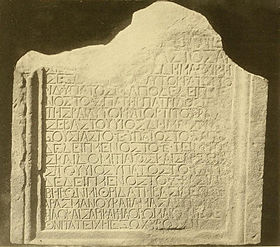|
Stele of Vespasian
The Stele of Vespasian (Georgian: ვესპასიანეს სტელა) is a stele celebrating Roman emperor Vespasian. It was written in Ancient Greek and found in 1867[2] at Armazi, near Mtskheta, Georgia in the ancient capital of the Caucasian Kingdom of Iberia. SteleThe stele memorialises reinforcement of the fortification of Armazi walls by Emperor Vespasian.[3][4] Additionally, the inscription mentions two emperors Titus, Domitian and two kings Mihrdat I of Iberia, Pharasmanes I of Iberia and prince royal Amazaspus. The inscription is dated to 75 AD.[3][5][6] The top of the stele is lost. According to Professor David Braund, the missing text was in Latin or Armazic (outgrowth of Aramaic language).[3][7] Cyril Toumanoff identifies Amazaspus as King Amazasp I of Iberia,[8] though it can be prince royal Amazaspus, son of Pharasmanes I of Iberia, who is known from the Epigram of Amazaspos found in Rome.[3] Inscription
ReferencesBibliography
|
||||||||||||||||||
